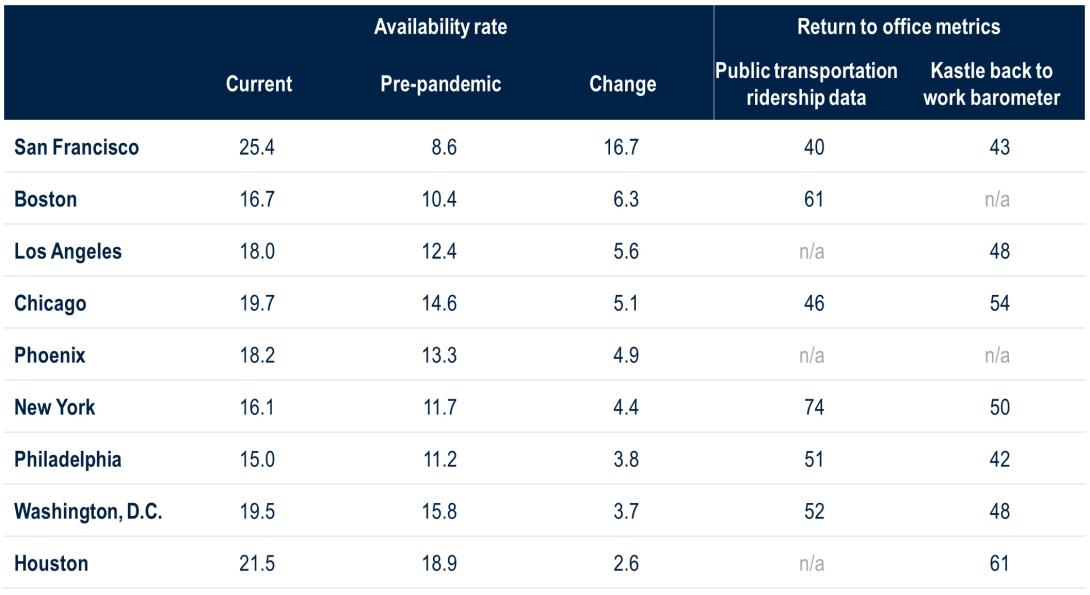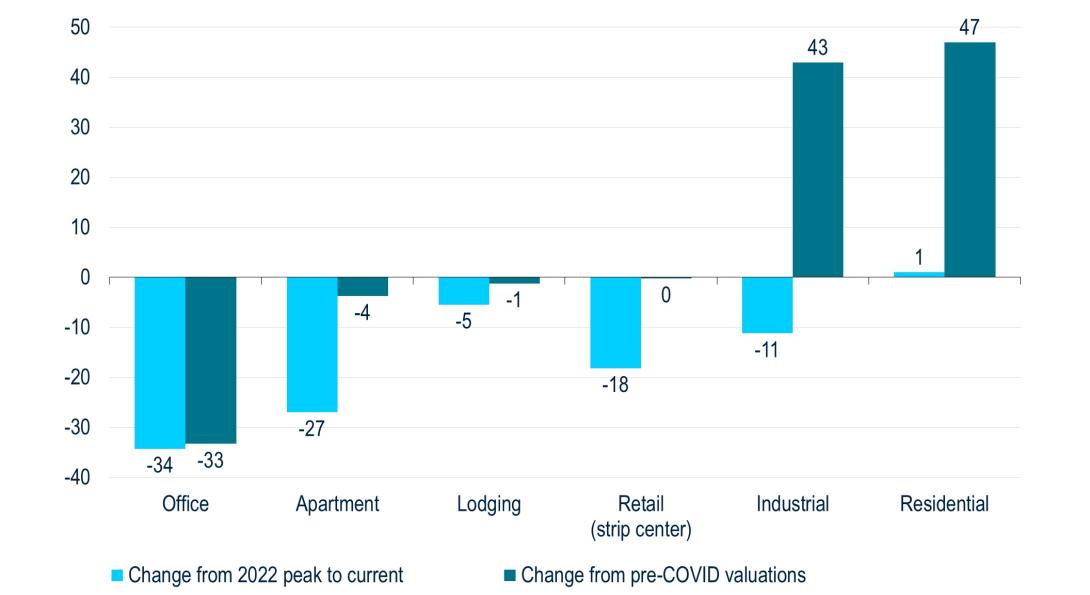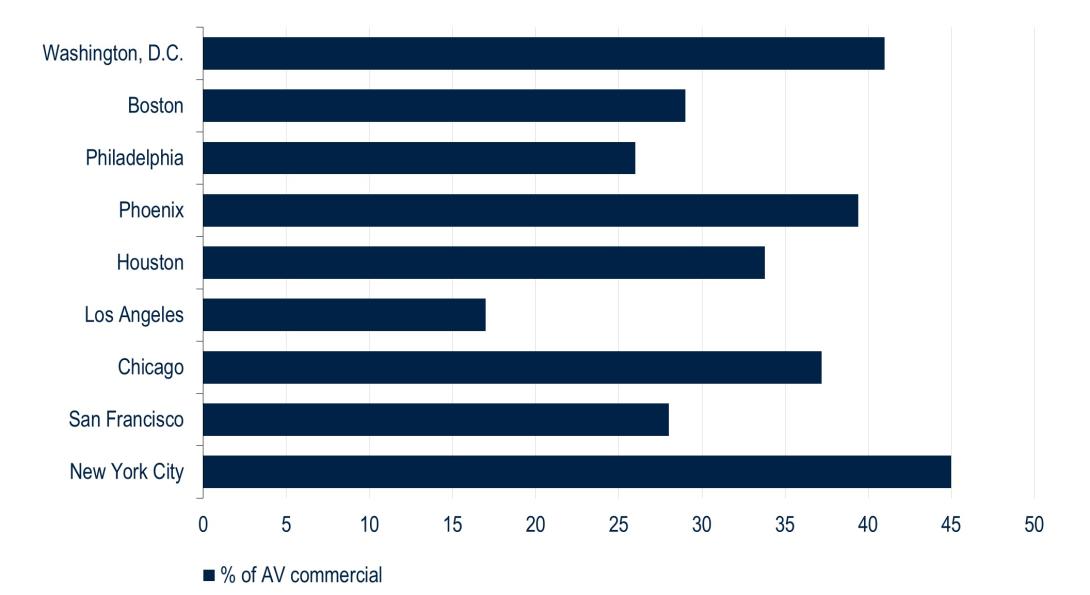Office Space: The CRE Effects On Major U.S. Cities

Since the end of the COVID-driven recession, a growing chorus has sounded an alarm about the impact of commercial real estate on the budgets of several major U.S. cities. In these instances, rising office vacancy rates, declining property valuations, and the respective impact on tax revenues and city budgets are a source of growing concern for municipal bond investors considering several cities are significant issuers within the market.
While we previously explored the effects that commercial real estate (CRE) may have on the CMBS sector, this post views the situation from the perspective of cities and municipal bond investors and we consider this challenge to be manageable for most cities. Indeed, our anticipation for fiscal deterioration in some cities needs to be placed in the context of performance dispersion across property types, revenue diversification, the proportion of revenues from CRE, and cities' flexibility to adjust tax rates as needed.1
CRE continues to face headwinds from multiple sources, including higher interest rates, weakening fundamentals, and tighter lending conditions (Figure 1). While commercial property values have already begun to correct, valuations are likely to adjust further as strains in the market become more ingrained and transaction volumes slowly increase.
Figure 1: CRE Valuations Will Take Time to Correct

Source: PGIM Fixed Income and CoStar CPPI as of November 2023.
While availability rates in the office sector continue to rise nationally as post-COVID work arrangements become more permanent, we expect significant performance dispersion across both property types and geography.2 Newer, well-located Class A properties can be expected to attract tenants and maintain asking rent levels, outperforming Class B and C properties in need of significant capital expenditures. In addition, performance will vary by region, with San Francisco as an example of a major city that continues to underperform (Figure 2).
Figure 2: Office Fundamentals Differ by City

Source: PGIM Fixed Income, CoStar, Kastle Systems, JP Morgan Research as of November 2023.
Diverging Fortunes
Despite this challenging backdrop for CRE, it is critical to remember the path that valuations for the sector as a whole have taken since COVID. For most property types outside of office, there was significant appreciation immediately following the onset of the pandemic. As a result, we expect non-office valuations to be near, or even above, pre-pandemic levels after the current correction (Figure 3).
Meanwhile, residential real estate values are up 47% from pre-COVID levels and are expected to remain resilient given the tailwind of strong demand and tight inventories.
Figure 3: Non-Office Valuations Expected to Remain Near or Above Pre-COVID Levels (%)

Source: PGIM Fixed Income, Case Schiller Home Price Index, Green Street Advisors as of October 2023. Pre-COVID defined as January 2020. Current CRE prices reflect Green Street’s appraisals.
A Diverse Tax Base
While U.S. cities receive an average of 30% of their revenues from property taxes, some cities, such as Phoenix and Philadelphia, collect much smaller portions. Others, such as Boston at more than double the national average, receive much larger portions (Figure 4).
Figure 4: Property Tax as a Percentage of Total Revenue
 Source: PGIM Fixed Income, City Audited Financial Statements as of the fiscal 2022 reporting year.
Source: PGIM Fixed Income, City Audited Financial Statements as of the fiscal 2022 reporting year.
Similarly, the proportion of real estate assessments generated from residential, commercial, and industrial classes varies from city to city, with some more exposed to a significant decline in CRE values (Figure 5).
Figure 5: Percent of Total Assessments Generated from Commercial Property

Source: PGIM Fixed Income, City Audited Financial Statements, Moody’s Investors Service as of the fiscal 2022 reporting year.
As an example, New York City generates 27% of its revenues from property taxes. However, only 45% of assessed values are commercial. Of those commercial assessments, only 53% are offices. Of those offices, only a portion (estimated at 60%) is categorized as Class B or Class C properties and, therefore, subject to severe declines in value. The net result may be that only 3-4% of New York’s revenues are related to Class B or Class C offices that are expected to decline in value.
While this will be a headwind to New York’s overall revenue growth, we view this as an example of manageable budget risk for the city, particularly in relation to its strong financial profile. While New York City experienced a $1.6 billion (5.1%) property tax revenue decline in 2022 due to contractions in CRE, the city maintained its strong credit profile. As of its last financial audit, New York maintained over $6 billion (or 5.7% of revenues) of surplus and fund balance reserves in its main operating fund.
Although highly unpopular to businesses and voters, many cities also have the legal ability to raise tax millage rates, or rate per $1,000 of assessed value, to make up for declining real estate assessments, which can help to keep property tax revenues relatively stable. While some cities have limitations on the amounts their millage rates can be raised, their assessment practices are typically conservative, lagged in timing and, therefore, provide a buffer against the volatile nature of real estate market values.
Although severity will vary by region, the diversity of revenues generally means that the decline in CRE valuations—and any potential decline in tax revenues—should be manageable for most U.S. cities.
The Limited Impact of Conversions
Considering the national home affordability and office vacancy situations, some cities are already considering plans to re-purpose some of the less desirable office space to residential properties. As they do so, cities are looking for ways to incentivize conversions of empty offices into affordable multi-family housing. We view this as having limited economic impact as these projects often require significant upfront investment. In some cases, a project may make economic sense given the potential for new revenue from parking or retail space. In other cases, a project may not be economical based on the cost of the property, conversion costs, number of units dedicated to low- and moderate-income residents, and financing costs. Therefore, we don’t view conversions as a wide-ranging remedy for lost revenues from lower CRE valuations.
While in the early stages, efforts by a few states and discussions at the Federal level to consider increasing subsidies to incentivize conversion projects have taken place. If governments commit to these subsidy programs, conversions could become more viable and widespread.
Retrofitting vacant offices may work in limited situations. However, these conversions likely won’t work on a mass scale without significant subsidies, thus limiting any potential benefit from a tax revenue perspective. That said, we expect the challenges to city budgets from declining CRE valuations to remain manageable. Although the challenges will affect overall tax revenues and cause some deterioration in certain cities’ fiscal situation, the fiscal consequences for most cities are likely to be minimal given the diversity of revenues, the relatively small portion of property taxes generated from commercial properties, and the flexibility to increase tax millage rates when assessments decline. Moreover, the divergence in commercial and residential property values may help to further smooth the overall impact on city budgets.
1 The dispersion across property types is consistent with our most recent fixed income themes. For more on our themes, please see our Q4 Market Outlook.
2 Availability rate is defined as the total amount of square footage available divided by the total rentable square footage. We view availability rate as a better indicator than vacancy rate in the current market environment as it accounts for subleasing.
Read More From PGIM Fixed Income
The comments, opinions, and estimates contained herein are based on and/or derived from publicly available information from sources that PGIM Fixed Income believes to be reliable. We do not guarantee the accuracy of such sources or information. This outlook, which is for informational purposes only, sets forth our views as of this date. The underlying assumptions and our views are subject to change. Past performance is not a guarantee or a reliable indicator of future results.
Source(s) of data (unless otherwise noted): PGIM Fixed Income, as of November 20, 2023.
For Professional Investors only. Past performance is not a guarantee or a reliable indicator of future results and an investment could lose value. All investments involve risk, including the possible loss of capital.
PGIM Fixed Income operates primarily through PGIM, Inc., a registered investment adviser under the U.S. Investment Advisers Act of 1940, as amended, and a Prudential Financial, Inc. (“PFI”) company. Registration as a registered investment adviser does not imply a certain level or skill or training. PGIM Fixed Income is headquartered in Newark, New Jersey and also includes the following businesses globally: (i) the public fixed income unit within PGIM Limited, located in London; (ii) PGIM Netherlands B.V., located in Amsterdam; (iii) PGIM Japan Co., Ltd. (“PGIM Japan”), located in Tokyo; (iv) the public fixed income unit within PGIM (Hong Kong) Ltd. located in Hong Kong; and (v) the public fixed income unit within PGIM (Singapore) Pte. Ltd., located in Singapore (“PGIM Singapore”). PFI of the United States is not affiliated in any manner with Prudential plc, incorporated in the United Kingdom or with Prudential Assurance Company, a subsidiary of M&G plc, incorporated in the United Kingdom. Prudential, PGIM, their respective logos, and the Rock symbol are service marks of PFI and its related entities, registered in many jurisdictions worldwide.
These materials are for informational or educational purposes only. The information is not intended as investment advice and is not a recommendation about managing or investing assets. In providing these materials, PGIM is not acting as your fiduciary. PGIM Fixed Income as a general matter provides services to qualified institutions, financial intermediaries and institutional investors. Investors seeking information regarding their particular investment needs should contact their own financial professional.
These materials represent the views and opinions of the author(s) regarding the economic conditions, asset classes, securities, issuers or financial instruments referenced herein. Distribution of this information to any person other than the person to whom it was originally delivered and to such person’s advisers is unauthorized, and any reproduction of these materials, in whole or in part, or the divulgence of any of the contents hereof, without prior consent of PGIM Fixed Income is prohibited. Certain information contained herein has been obtained from sources that PGIM Fixed Income believes to be reliable as of the date presented; however, PGIM Fixed Income cannot guarantee the accuracy of such information, assure its completeness, or warrant such information will not be changed. The information contained herein is current as of the date of issuance (or such earlier date as referenced herein) and is subject to change without notice. PGIM Fixed Income has no obligation to update any or all of such information; nor do we make any express or implied warranties or representations as to the completeness or accuracy.
Any forecasts, estimates and certain information contained herein are based upon proprietary research and should not be interpreted as investment advice, as an offer or solicitation, nor as the purchase or sale of any financial instrument. Forecasts and estimates have certain inherent limitations, and unlike an actual performance record, do not reflect actual trading, liquidity constraints, fee. These materials are not intended as an offer or solicitation with respect to the purchase or sale of any security or other financial instrument or any investment management services and should not be used as the basis for any investment decision. PGIM Fixed Income and its affiliates may make investment decisions that are inconsistent with the recommendations or views expressed herein, including for proprietary accounts of PGIM Fixed Income or its affiliates.
Investing in the bond market is subject to risks, including market, interest rate, issuer, credit, inflation risk, and liquidity risk. The value of most bonds and bond strategies are impacted by changes in interest rates. Bonds and bond strategies with longer durations tend to be more sensitive and volatile than those with shorter durations; bond prices generally fall as interest rates rise, and low interest rate environments increase this risk. Reductions in bond counterparty capacity may contribute to decreased market liquidity and increased price volatility. Bond investments may be worth more or less than the original cost when redeemed. Mortgage- and asset-backed securities may be sensitive to changes in interest rates, subject to early repayment risk, and while generally supported by a government, government agency or private guarantor, there is no assurance that the guarantor will meet its obligations. High yield, lower-rated securities involve greater risk than higher-rated securities; portfolios that invest in them may be subject to greater levels of credit and liquidity risk than portfolios that do not. Investing in foreign-denominated and/or -domiciled securities may involve heightened risk due to currency fluctuations, and economic and political risks, which may be enhanced in emerging markets. Currency rates may fluctuate significantly over short periods of time and may reduce the returns of a portfolio. Commodities contain heightened risk, including market, political, regulatory and natural conditions, and may not be suitable for all investors. Diversification does not ensure against loss.
In the United Kingdom, information is issued by PGIM Limited with registered office: Grand Buildings, 1-3 Strand, Trafalgar Square, London, WC2N 5HR.PGIM Limited is authorised and regulated by the Financial Conduct Authority (“FCA”) of the United Kingdom (Firm Reference Number 193418). In the European Economic Area (“EEA”), information is issued by PGIM Netherlands B.V., an entity authorised by the Autoriteit Financiële Markten (“AFM”) in the Netherlands and operating on the basis of a European passport. In certain EEA countries, information is, where permitted, presented by PGIM Limited in reliance of provisions, exemptions or licenses available to PGIM Limited including those available under temporary permission arrangements following the exit of the United Kingdom from the European Union. These materials are issued by PGIM Limited and/or PGIM Netherlands B.V. to persons who are professional clients as defined under the rules of the FCA and/or to persons who are professional clients as defined in the relevant local implementation of Directive 2014/65/EU (MiFID II). In Switzerland, information is issued by PGIM Limited, London, through its Representative Office in Zurich with registered office: Kappelergasse 14, CH-8001 Zurich, Switzerland. PGIM Limited, London, Representative Office in Zurich is authorised and regulated by the Swiss Financial Market Supervisory Authority FINMA and these materials are issued to persons who are professional or institutional clients within the meaning of Art.4 para 3 and 4 FinSA in Switzerland. In certain countries in Asia-Pacific, information is presented by PGIM (Singapore) Pte. Ltd., a regulated entity with the Monetary Authority of Singapore under a Capital Markets Services License to conduct fund management and an exempt financial adviser. In Japan, information is presented by PGIM Japan Co. Ltd., registered investment adviser with the Japanese Financial Services Agency. In South Korea, information is presented by PGIM, Inc., which is licensed to provide discretionary investment management services directly to South Korean investors. In Hong Kong, information is provided by PGIM (Hong Kong) Limited, a regulated entity with the Securities & Futures Commission in Hong Kong to professional investors as defined in Section 1 of Part 1 of Schedule 1 of the Securities and Futures Ordinance (Cap.571). In Australia, this information is presented by PGIM (Australia) Pty Ltd (“PGIM Australia”) for the general information of its “wholesale” customers (as defined in the Corporations Act 2001). PGIM Australia is a representative of PGIM Limited, which is exempt from the requirement to hold an Australian Financial Services License under the Australian Corporations Act 2001 in respect of financial services. PGIM Limited is exempt by virtue of its regulation by the FCA (Reg: 193418) under the laws of the United Kingdom and the application of ASIC Class Order 03/1099. The laws of the United Kingdom differ from Australian laws. In Canada, pursuant to the international adviser registration exemption in National Instrument 31-103, PGIM, Inc. is informing you that: (1) PGIM, Inc. is not registered in Canada and is advising you in reliance upon an exemption from the adviser registration requirement under National Instrument 31-103; (2) PGIM, Inc.’s jurisdiction of residence is New Jersey, U.S.A.; (3) there may be difficulty enforcing legal rights against PGIM, Inc. because it is resident outside of Canada and all or substantially all of its assets may be situated outside of Canada; and (4) the name and address of the agent for service of process of PGIM, Inc. in the applicable Provinces of Canada are as follows: in Québec: Borden Ladner Gervais LLP, 1000 de La Gauchetière Street West, Suite 900 Montréal, QC H3B 5H4; in British Columbia: Borden Ladner Gervais LLP, 1200 Waterfront Centre, 200 Burrard Street, Vancouver, BC V7X 1T2; in Ontario: Borden Ladner Gervais LLP, 22 Adelaide Street West, Suite 3400, Toronto, ON M5H 4E3; in Nova Scotia: Cox & Palmer, Q.C., 1100 Purdy’s Wharf Tower One, 1959 Upper Water Street, P.O. Box 2380 -Stn Central RPO, Halifax, NS B3J 3E5; in Alberta: Borden Ladner Gervais LLP, 530 Third Avenue S.W., Calgary, AB T2P R3.
© 2023 PFI and its related entities.
2023-82641
Sign Up Now for Full Access to Articles and Podcasts!
Unlock full access to our vast content library by registering as an institutional investor .
Create an accountAlready have an account ? Sign in
